Bamboo identification guide
Identification can be difficult as there are so many different types of Bamboo plants. Popular in many gardens, many are non-invasive. Some, however, can grow out of control and begin to take over the garden, in some cases spreading to neighbouring properties
One of the issues with most bamboo species is the speed of growth and the way they can suddenly take over a garden, potentially causing damage to areas such as patios and paths. As with Japanese knotweed, it’s also the rhizomes that spread underground that can cause the biggest issue and make this a difficult plant to eradicate
Our bamboo identification guide looks at how to spot this plant in your garden and how to decide whether it is invasive or not so that you can deal with it before it gets out of control
Quick facts
- Bamboo species are native to warm, tropical and temperate regions.
- There are around 1,400 different species.
- They are members of the grass family, Bambusoideae.
- Most are evergreen in the UK climate.




What is bamboo?
Bamboo itself has increased in popularity itself over the last 20 years. It is farmed extensively around the world and is used to create eco-friendly products from cutting boards to toys and even clothes. It’s a versatile material that can be grown quickly in a variety of different soil types and conditions.
Bamboo is technically a grass, and some species can grow as much as a foot a day. Identifying specific bamboo species can be challenging as there are over 1,400 different ones. The tallest will grow as high as 40 metres and these types of bamboo are most often seen in regions such as South and East Asia. In the UK, as far as bamboo identification is concerned, you are only likely to come across temperate varieties, which, depending on the variety will take one of two growth forms:
- Running bamboo: This develops rhizomes underground which extend away from the initial plant. Each rhizome can then grow a separate culm or stem which can spread throughout your garden.
- Clumping bamboo: This tends to form over a compact area and is generally easier to manage. Essentially, you can identify these species of bamboo because new shoots appear very closely to the root balls, and these bamboo types spread slowly.
When it comes to being invasive, running bamboo is far more troublesome for UK properties and, if left unattended, can begin to spread very quickly. Of course, this also depends on the species. There are several ways to identify bamboo including the shape and size of the leaves, what the stems look like, and the roots.
The big question most homeowners have is if bamboo is identified on their property, should they be worried?
It all depends on the species, how widely and quickly it spreads, and how invasive it can be. Currently, bamboo is not considered an invasive species like Japanese knotweed but mortgage companies are taking a closer look at it with regards to whether some properties have an issue or not. There are cases where neighbours have taken legal action after bamboo has spread from one property to another.
If you are thinking of buying a property and you have identified bamboo on it, it’s worth taking a closer look and carrying out a full survey to make sure there are no underlying problems.
Bamboo leaves: what do they look like?
Depending on the bamboo species, their leaves can be long or short but are generally shaped like a lance or spear that tapers to a point. The leaves tend to be tough and a little leathery and they are often used in cooking in Asia. Bamboo leaves are also used in traditional medicine, as animal fodder, and in the construction of things like roofs and baskets. Mostly the leaves of bamboo are green, but some species have variegated leaves, with white, or pale green stripes.
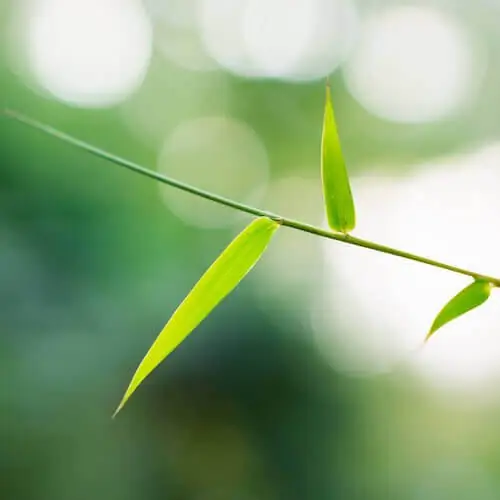
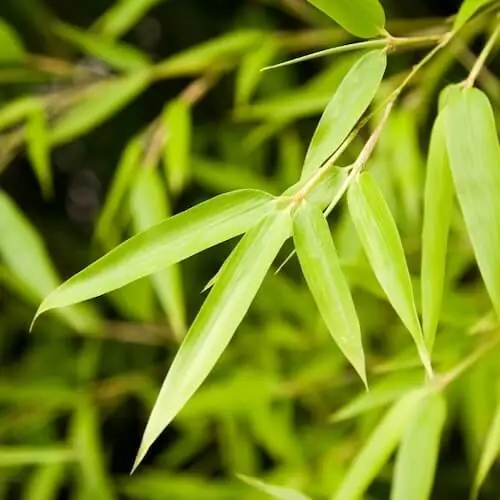
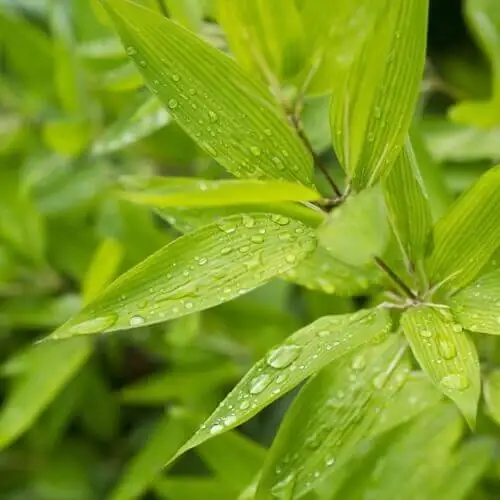
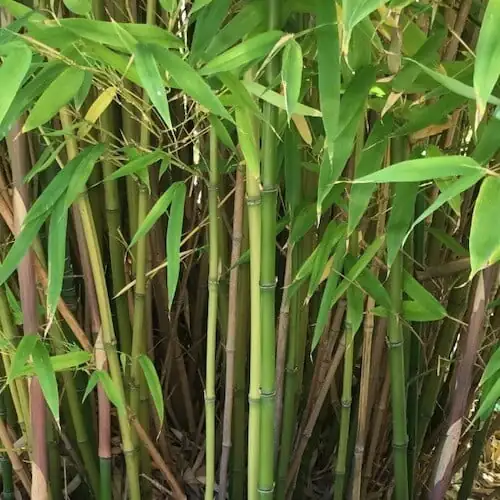
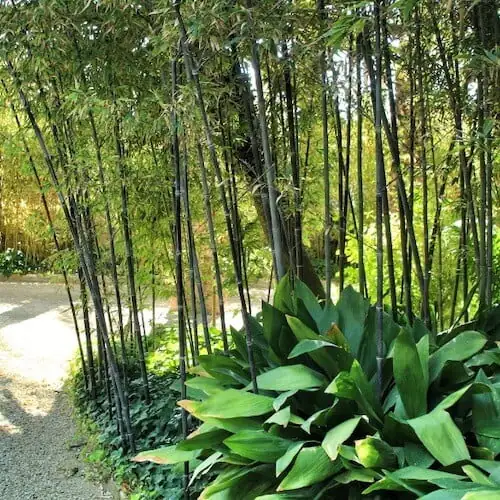
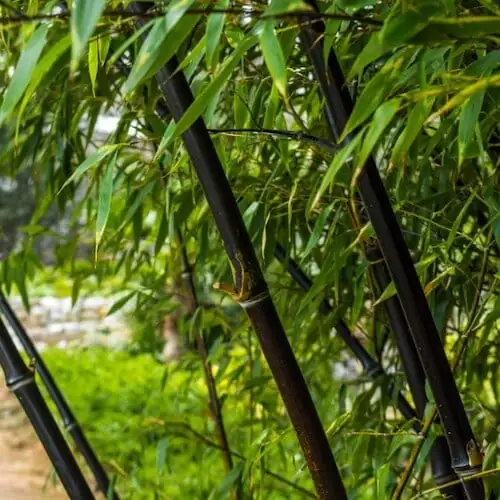
Bamboo stems: what do they look like?
The most distinctive part of the bamboo is the stem or culm which is usually rounded and quite thick. This is the part that you see above ground and is very distinctive in appearance.
The length of it will be broken up by horizontal nodes which are a slightly different colour and create a ridge on the stem. Branches, if there are any, will generally emerge from these ridges and can form offshoots with leaves.
Most bamboo species have smooth stems, but a key characteristic of the Phyllostachys group is a defined ridge or groove on the stem, often changing sides after each node.
Bamboo roots: what do they look like?
As with many invasive and troublesome plants, it’s what’s going on underground that is often more important.
Rhizomes are not exactly roots in the traditional sense but are another part of the plant that grows underground and can spread horizontally. Like the stems, these develop nodes from which new growths above ground can occur. In running bamboo, these rhizomes spread horizontally and may finally take over a garden, damaging other plants. Because they are quite tough, they may even work their way into areas like building foundations causing structural problems.
The roots initially grow quite shallowly in the soil but once the bamboo of certain species has gained a hold (after around 5-10 years) they can be tough to remove using simple garden tools – that’s why it’s important to have more serious infestations handled by a professional team with the right equipment.
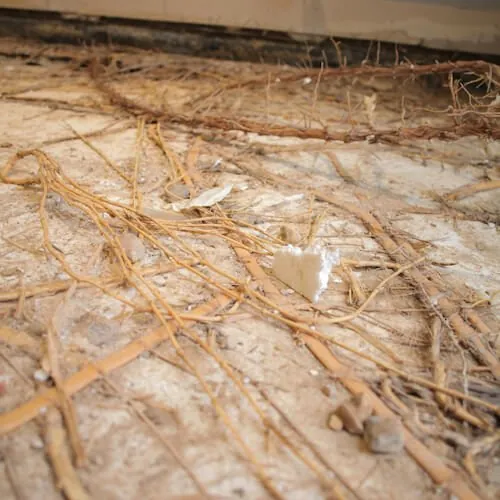
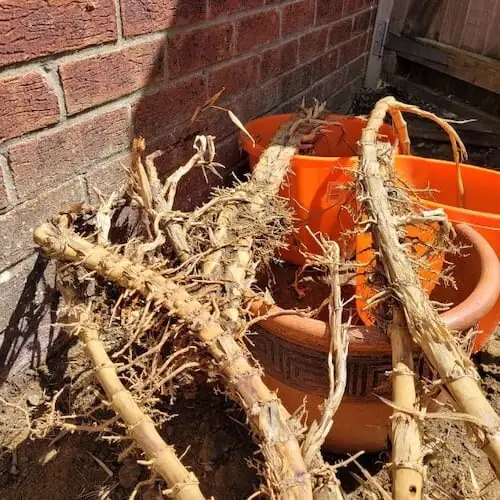
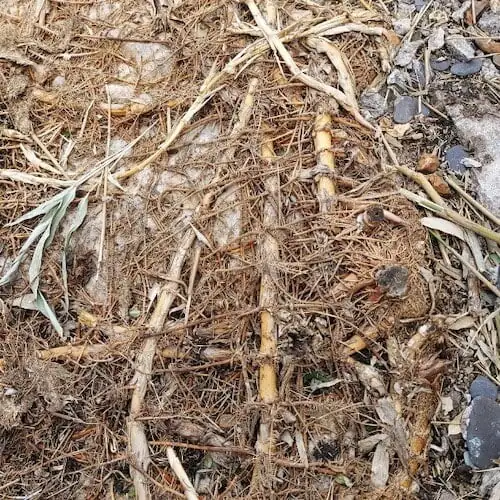
Identifying different types of bamboo
With over a thousand different bamboo types, you won’t be surprised to learn that there are some variations between the species that you might find invading your garden.
Planting bamboo in the garden has become increasingly popular in the UK and, for the most part, as long as the growth is properly managed, there is little or no problem. Gardening experts and landscapers suggest that you stick to clumping types of bamboo if you want to put them in your garden, as these tend to remain in one place and not spread.
If you are looking to buy a house and there seems to be a bamboo problem, however, it’s important to get the area assessed and identify the bamboo type you are dealing with, as some can be very invasive. They can also spread from neighbouring gardens and begin to take over everything from the lawn and patio to your plant beds.
There are several different types of running bamboo that can quickly grow across your garden and onto the neighbour’s property if you are not careful.
These include:

Phyllostachys
While these can form clumps as well, they are mainly classed as running bamboo. There are about 50 different species and it’s important to investigate how each is likely to affect your garden. This family has a distinctive groove on the culm. P. aurea and P. nigra are both highly popular and are quite striking but be warned, they can also spread quickly and grow several metres in height.

Sasa & Sasaella
Commonly known as Japanese bamboo, these variegated varieties with white and green striped leaves can produce spreading clumps of stems that reach about 2 metres in height. They are evergreen and can look highly attractive if you want an ornamental plant in your garden but can spread widely if not contained.

Bashania
Less commonly available in the UK, they can grow 7 metres tall or more are characterised by deep olive stems and leaves, and are often used for hedging or screens in the garden. If managed correctly, they can be an attractive addition but will become invasive in warm, moist conditions.

Pleioblastus
Pleioblastus varieties are dwarf bamboos, making them popular for ground cover. Small they may be, but they are also very hardy and can spread vigorously. Once they have invaded your borders, the runners grow through the root systems of other plants, making removal difficult.

How tall does bamboo grow?
One of the first questions people tend to ask is how high does bamboo grow? You won’t be surprised to learn that this largely depends on the species. Some only grow a few metres others can, when allowed to flourish, reach ten metres or more.
The largest species of bamboo, which is not seen in the UK, is called Dendrocalamus sinicus and that can grow to heights of nearly 50 metres (about the size of two tennis courts).
How fast does bamboo grow in the UK?
One of the characteristics that make bamboo such a good manufacturing material is the speed with which it grows. Stems can be cut down and within a few months are replenished. The growth rate of Bamboo depends on the species – some can grow as quickly as 91 centimetres in 24 hours.
How quickly does bamboo grow in the UK? Left unattended, clumping bamboo varieties will grow around 1 to 2 feet every year. Running bamboo is more vigorous and a stem is likely to grow 3 to 4 feet in a year but may also spread across the ground.
Identifying the type of bamboo you have in your garden will help you understand how invasive it is likely to be and what you need to do if you want to get rid of it. In many cases, bamboo can be managed quite easily and, if you find it attractive in your garden, there’s no reason to have it removed.
If you have identified bamboo in your garden and now want rid of it, getting a specialist team in to handle the removal makes sense. They will have the right tools and equipment, particularly important if the growth covers a large area.
At Environet, we’ve got the expertise and the solutions you need to rid your property of a wide range of different invasive species.

Start fixing your invasive plant problem today by requesting a survey
Request a survey
Rest assured, where invasive species are identified at an early stage and tackled correctly, problems can usually be avoided. Our specialist consultants complete thorough surveys to identify the extent of the problem. Our plans aren’t one-size-fits-all; they’re customised to tackle the invasive species at your property effectively, taking account of all of your requirements.
Quick Links
What our clients say
Reviews
What our clients say
Reviews
Ali Hamaad
“I used Environet following a recommendation to help with invasive Japanese Knotweed in my garden. Very professional, responsive and managed to co-ordinate with other contractors working on my property to remove the knotweed.”
Bernadette Spencer
“Richard was able to book us an assessment visit very quickly regarding the encroachment of evasive running bamboo in our garden .. Will completed the assessment visit,we found him to be very professional, but also friendly and easy to talk to. “
Phil Smith
“This is a very professional operation; always just on the end of the phone. The whole team seemed to know exactly what was going on with the job. (and my neighbours were very happy too.)”
L Schjolden
“I would like to commend your man Ed, who was in charge of the works at our property. He was a pleasure to deal with — punctual, polite, professional, responsible. He always kept me up to date with the progress of the works and made sure there was as little disruption to our lives as possible.”
L Schjolden
“I would like to commend your man Ed, who was in charge of the works at our property. He was a pleasure to deal with — punctual, polite, professional, responsible. He always kept me up to date with the progress of the works and made sure there was as little disruption to our lives as possible.”
GET IN TOUCH
Contact us
Our team of experts is available between 9am and 5:30pm, Monday to Friday to answer your enquiries and advise you on the next steps
Want a survey?
If you already know you have an invasive plant problem, you can request a survey online in less than two minutes by providing a few brief details. A member of the team will swiftly come back to you with further information and our availability.
Need quick plant identification?
Simply upload a few images of your problem plant to our identification form and one of our invasive plant experts will take a look and let you know, free of charge what you are dealing with. We’ll also be there to help with next steps where necessary.



